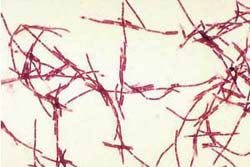Research Reveals How Anthrax Attacks

With each day seemingly bringing a new case of anthrax infection, interest in developing treatments for the potentially fatal disease has reached an all-time high. To that end, two reports released yesterday by the journal Nature should help, providing greater understanding of the mechanism by which the anthrax toxin kills host cells.
Previous work had shown that after entering a host, the anthrax bacterium, Bacillus anthracis (see image), secretes a toxin comprised of three parts. One of these, protective antigen (PA), binds to the outside of the cell and mediates entry of the other two—edema factor (EF) and lethal factor (LF). Once inside, EF and LF use enzymes to destroy the cell.
In one of the new studies, John A. T. Young of the University of Wisconsin-Madison and colleagues identified the receptor that PA binds to in humans. Starting with cells resistant to the anthrax toxin, the scientists first determined that resistance stems from the absence of a receptor for the anthrax toxin. They then introduced genes into the cells until they found one that restored receptor production. It turns out the protein produced by that gene, dubbed anthrax toxin receptor (ATR), features a region that protrudes from the cell membrane, providing a docking site for PA. In subsequent in vitro experiments, adding synthesized copies of the receptor to the extracellular environment protected cells from anthrax by providing alternative binding sites for the toxin. „The identification of ATR,“ the team writes, „now allows for a more detailed investigation of the mechanism of uptake by cells of anthrax toxin.“
The second report, by Robert Liddington of the Burnham Institute in La Jolla, Calif., and colleagues, describes in detail the structure of LF. This protein „has evolved through a process of gene duplication, mutation and fusion, into an enzyme with high and unusual specificity,“ the authors note. They conclude that the new structural information „can be used in the design of therapeutic agents that would block the activity of LF.“ Of course, such therapies are still years away from practical use, so for now treatment will continue to rely on the use of antibiotics to kill the anthrax bacterium.
Media Contact
Weitere Informationen:
http://www.scientificamerican.com/news/Alle Nachrichten aus der Kategorie: Medizin Gesundheit
Dieser Fachbereich fasst die Vielzahl der medizinischen Fachrichtungen aus dem Bereich der Humanmedizin zusammen.
Unter anderem finden Sie hier Berichte aus den Teilbereichen: Anästhesiologie, Anatomie, Chirurgie, Humangenetik, Hygiene und Umweltmedizin, Innere Medizin, Neurologie, Pharmakologie, Physiologie, Urologie oder Zahnmedizin.
Neueste Beiträge

Neue universelle lichtbasierte Technik zur Kontrolle der Talpolarisation
Ein internationales Forscherteam berichtet in Nature über eine neue Methode, mit der zum ersten Mal die Talpolarisation in zentrosymmetrischen Bulk-Materialien auf eine nicht materialspezifische Weise erreicht wird. Diese „universelle Technik“…

Tumorzellen hebeln das Immunsystem früh aus
Neu entdeckter Mechanismus könnte Krebs-Immuntherapien deutlich verbessern. Tumore verhindern aktiv, dass sich Immunantworten durch sogenannte zytotoxische T-Zellen bilden, die den Krebs bekämpfen könnten. Wie das genau geschieht, beschreiben jetzt erstmals…

Immunzellen in den Startlöchern: „Allzeit bereit“ ist harte Arbeit
Wenn Krankheitserreger in den Körper eindringen, muss das Immunsystem sofort reagieren und eine Infektion verhindern oder eindämmen. Doch wie halten sich unsere Abwehrzellen bereit, wenn kein Angreifer in Sicht ist?…





















